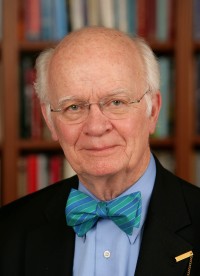What 'is' is
Catechism class will now come to order. Either because of bad teaching in the preceding generation or because one kid did not pay attention, a crucial misstatement of doctrine has been repeated in the press.
In the Chicago Tribune Lois Smallwood reported that former Lutheran pastor Dave Medow has become a deacon in the Roman Catholic Church—a step on his way to the priesthood. So far so good. The priest shortage in Catholicism is even more of a crisis than the ministerial shortage in Protestantism. Sending or lending married pastors to Catholic churches is a generous ecumenical gesture. It might also remind future popes that Catholicism has room for priests with spouses.
However, according to Smallwood, Medow said that the reason he had turned away from Lutheranism was because “Lutherans believe the consecrated bread and wine offered at Communion represent the body and blood of Christ,” whereas Catholics believe they are the body and blood of Christ. Perhaps Smallwood got it wrong, but these matters are so technical that I picture her faithfully reproducing what she heard, so let’s assume this is Medow talking.
Medow, therefore, was either badly taught or was not paying attention in catechism class. Let’s look at church history. Philip of Hesse was trying to bring Lutherans and Reformed together at Marburg in 1529. The two parties agreed on 14 of 15 points. But Luther was unyielding about insisting that the bread and wine is the body and blood of Jesus, an interpretation the Reformed opposed.
I remember being told in catechism class that Luther emphasized the “is” business by dramatically chalking on the table the Latin version of the biblical words of Jesus, “this is my body”: Hoc est corpus meum. (I recall wondering what would happen to us eighth graders if our pastor or teacher caught us scribbling on the table, but . . .)
Zwingli, the leader of the Reformed, had hoped to seal the deal with tears of joy. But because he and Luther differed on that “is” (versus “represents” and its synonyms) Luther snorted, “Ye have another spirit than ours.” And went his separate way. Protestantism was divided over that issue of “is” and “represents” for 450 years, until American Lutherans (ELCA) and Reformed were able to agree they were of the same spirit and held to the same substance of the faith. They now enjoy “full communion” and can exchange ministers.
Now, Luther, it is true, thought that transubstantiation as then taught by the Catholic Church referred to some kind of magic. It’s viewed somewhat differently in today’s Catholicism, and Lutherans and Catholics now agree on “the real presence” of Christ in the sacrament. Some ecumenical theologians would say that many Protestants spent 4.5 centuries dealing with what the word “represents” means and trying to purge it of adjectives like “mere” (before “representation”) and “merely” before (“represents”). All associate words like “faith” and “the word” of God with the bread and wine.
One cannot entirely fault Deacon Medow for being confused. Had I been permitted chalk on the table as a catechism kid I would have diagrammed the ways we were taught to deal with “is.” Thus: The believer, in the face of “the word” associated with the bread and the wine, in faith receives “in and under” the elements what “is” the true body and blood of Jesus. Or something like that. We called the teaching a “mystery.” But the last thing we would have said is that the bread and wine “represent” the body and blood.
Hoc est corpus meum: “This IS . . .”
Maybe it all comes down to the definition of what “is” is.





